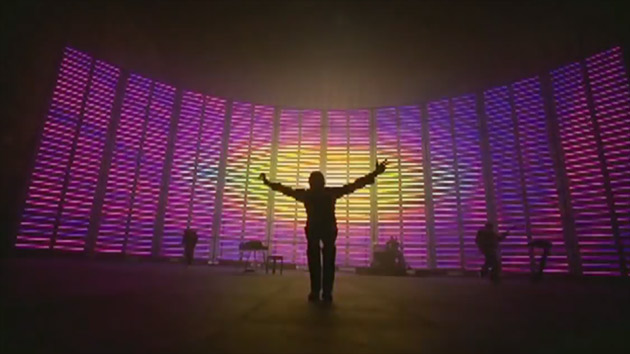An inventive stylist who rarely repeats himself, Mark Romanek has found ways to amplify pop music on film in quirky, personal ways. He's done it for Beck, David Bowie, Jay-Z and Johnny Cash. Recently the director reached a little further, mixing filmmaking with live concert showmanship in a clip for Coldplay's " Speed of Sound." The result is a cinematic light show that pushed Romanek's crew to get big performances out of a lighting board and a room full of light emitting diodes.
The building block of the video is a a tubular LED called the Versa Tube. Once he discovered that it could be mapped with video, production designer Michael Keeling opted to build a giant Venetian blind-like rack of 640 lights that would rise up behind the band and display animations timed to the music. Soon LEDs had taken over and were also used by DP Harris Savides as key lights that illuminated talent with either video or white light.
The animation that lights up the big board was created by Vello Virhaus, president of V Squared Labs in North Hollywood, with Apple Motion and Adobe After Effects and then programmed for the wall by lighting designer Martin Phillips. Six animations driven by vocal and instrumental stems from the song's mix were loaded into a PRG Mbox Media Server that had been customized for DVI output. From there the content was pushed into Element Labs' Versa Drive D2 processors, which fed the Versa Tube wall and the smaller LED arrays used for keylighting.
Phillips made the light show interact with the performance by controlling the custom animation and realtime effects generation from a Whole Hog II lighting board. "Figuring out how to control a number of separate banks of Versa Tubes individually as keylights sounds easy," Phillips reports by email from a Billy Corgan tour date in Europe, "but it was the toughest technical challenge."
The lighting story wasn't over at the wrap but continued to evolve even after the edit by Rock Paper Scissors' Adam Pertofsky. Romanek wanted to intensify the lighting effects as the mood of the video changes. To get the intensity of color that Romanek decided he wanted took several days of Inferno and Flame work at A52 in West Hollywood. Pat Murphy spent hours re-lighting and color correcting to emphasize blue in the first section, then red, and finally gold. "A lot of the close-ups didn't give the same feel as the wide shots," says Murphy, "So we were basically manipulating the back-wall light and adding lights to make wide shots and close-ups match closer together."

Leave a Reply